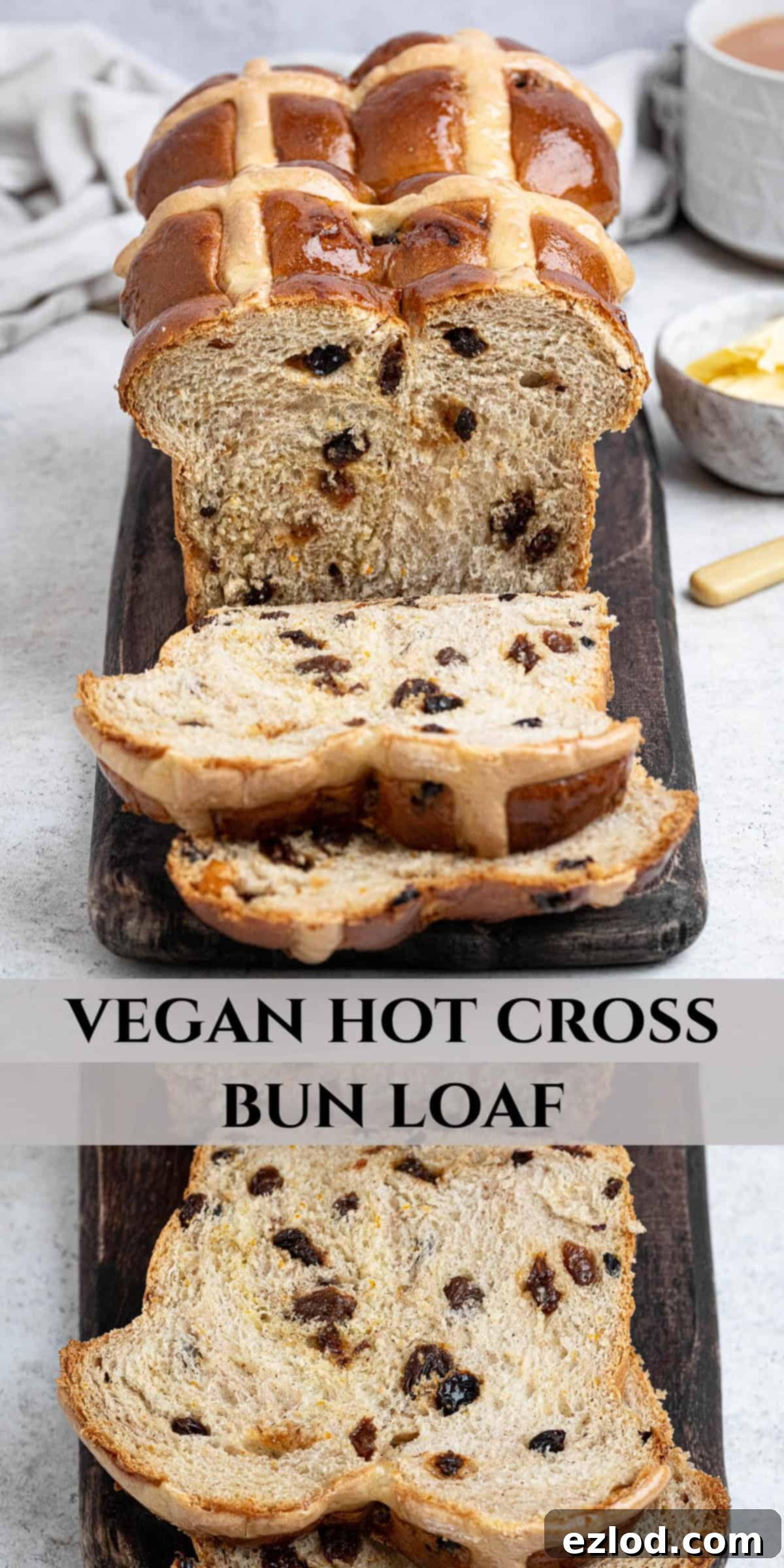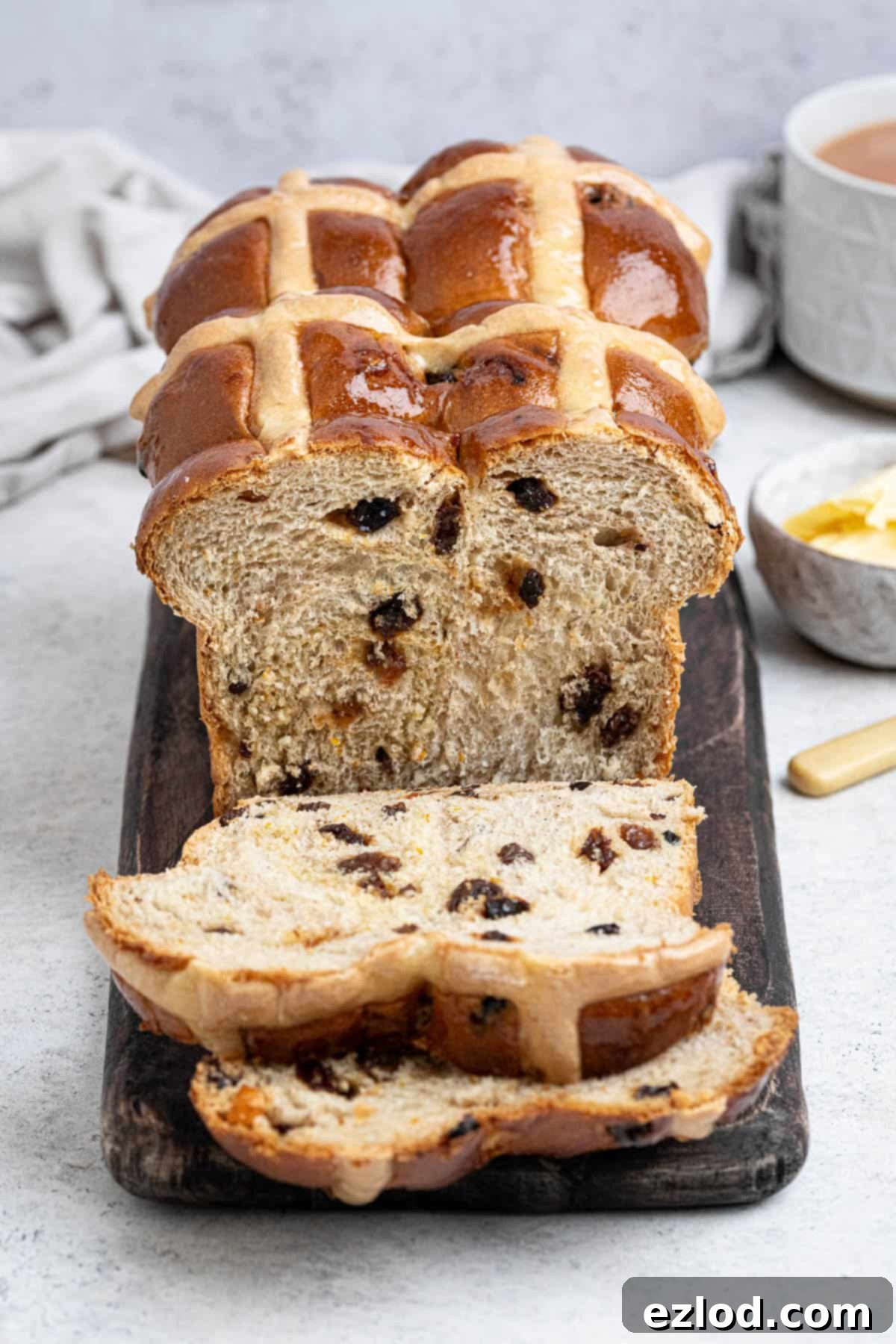Vegan Hot Cross Bun Loaf: Super Soft Easter Bread with Tangzhong Method
Embrace the spirit of Easter with this delightful Hot Cross Bun Loaf, a magnificent twist on the beloved British classic. This recipe delivers an exceptionally soft, fluffy, and utterly delicious bread, perfect for sharing (or enjoying all to yourself!). Crafted using the ingenious tangzhong method, this vegan loaf promises a tender crumb that stays fresh and wonderfully soft for days. Each slice is a harmonious blend of sweet, lightly spiced flavors, generously studded with a vibrant mix of dried fruits.
The joy of holidays and celebrations often revolves around special foods, and baked goods hold a particularly cherished place. There’s something inherently magical about indulging in treats that only make an appearance once a year, making them feel extra special and worth savoring. While classic hot cross buns are an undeniable Easter favorite, and the rich flavors of Simnel cake are always welcome, my heart truly belongs to sweet, enriched breads.
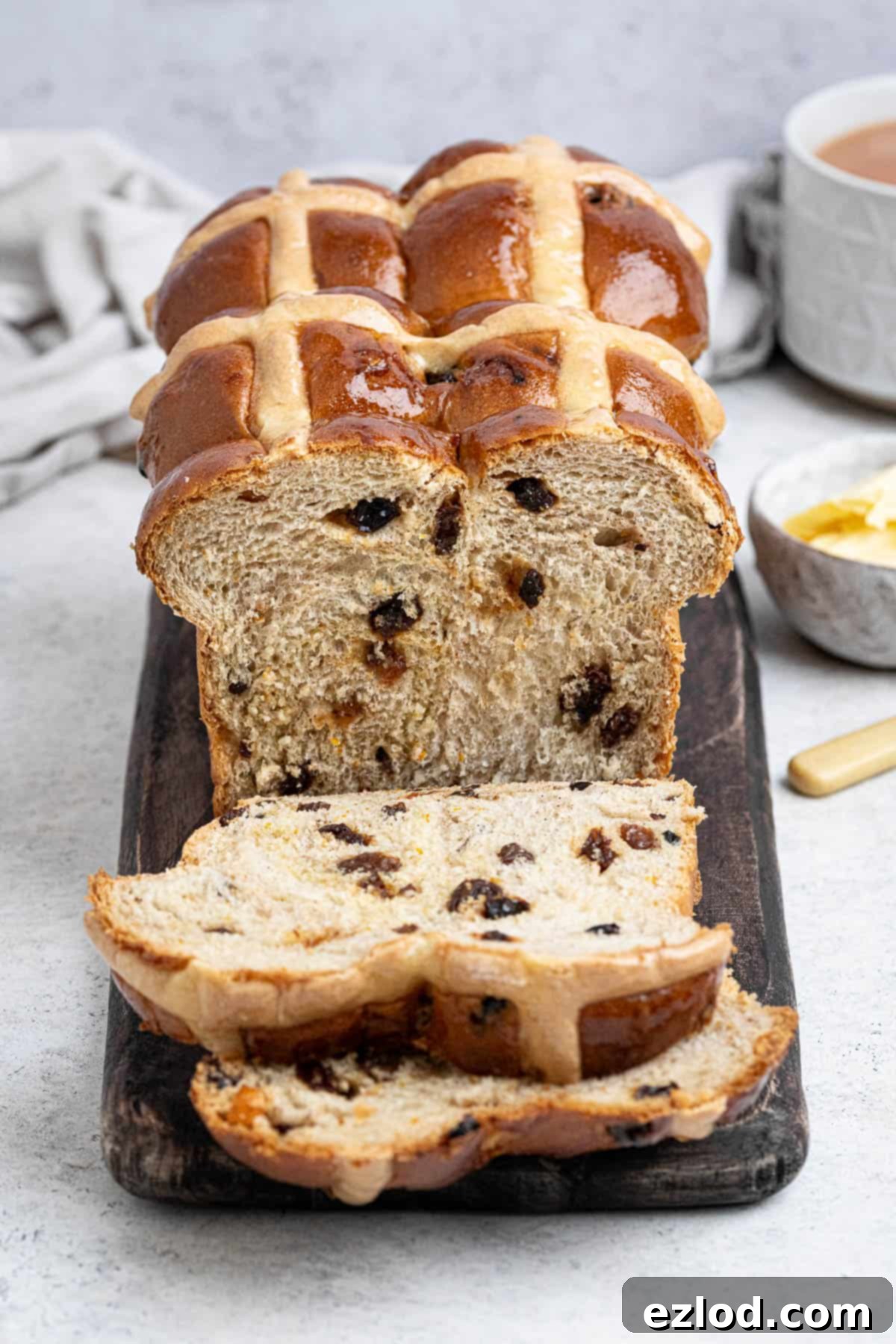
For years, baking at least one batch of traditional hot cross buns around Easter has been a cherished tradition. However, this year, I decided to venture into something a little different and created this spectacular Hot Cross Bun Loaf. The inspiration? My absolute favorite bread recipe: the incredibly soft and airy Vegan Hokkaido Milk Bread. This base recipe, celebrated for its unique texture and incredible longevity, proved to be the perfect foundation for a truly exceptional Easter treat.
Hokkaido milk bread, while perhaps not the quickest to knead by hand due to its sticky dough, is undeniably worth every bit of effort. If you’re lucky enough to own a stand mixer, the process becomes almost effortless! What sets this bread apart is its unparalleled softness and delicate sweetness, qualities that miraculously persist for several days – a rare feat among most homemade breads. Though, I must admit, making it last that long requires a level of willpower I often lack when faced with such deliciousness!
Transforming this milk bread into a festive hot cross bun loaf is surprisingly simple. The core technique remains, but we infuse it with the quintessential flavors of Easter. All it takes is the addition of aromatic mixed spice, bright orange zest, and a generous scattering of mixed dried fruit to the basic milk bread dough. Before baking, delicate crosses are piped onto the top, and once out of the oven, a brush of warm apricot jam provides that iconic, glossy finish and an extra layer of fruity sweetness.
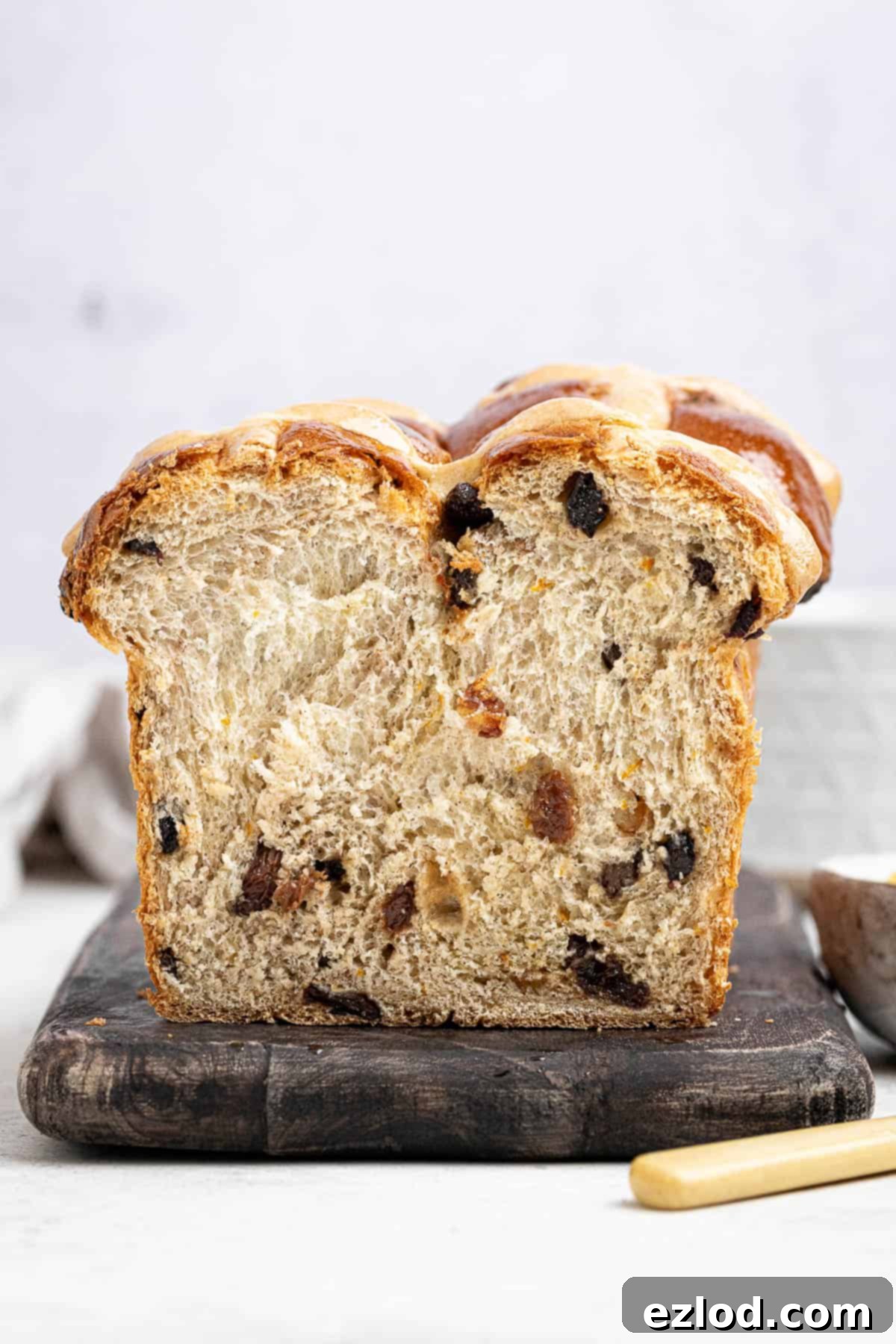
This Hot Cross Bun Loaf offers all the traditional charm and flavor of individual hot cross buns but with the added convenience and elegance of a sliced loaf. It’s perfect for breakfast, brunch, or a festive afternoon tea. Whether toasted and slathered with vegan butter or enjoyed plain, its spiced, fruity goodness is sure to be a highlight of your Easter celebrations.
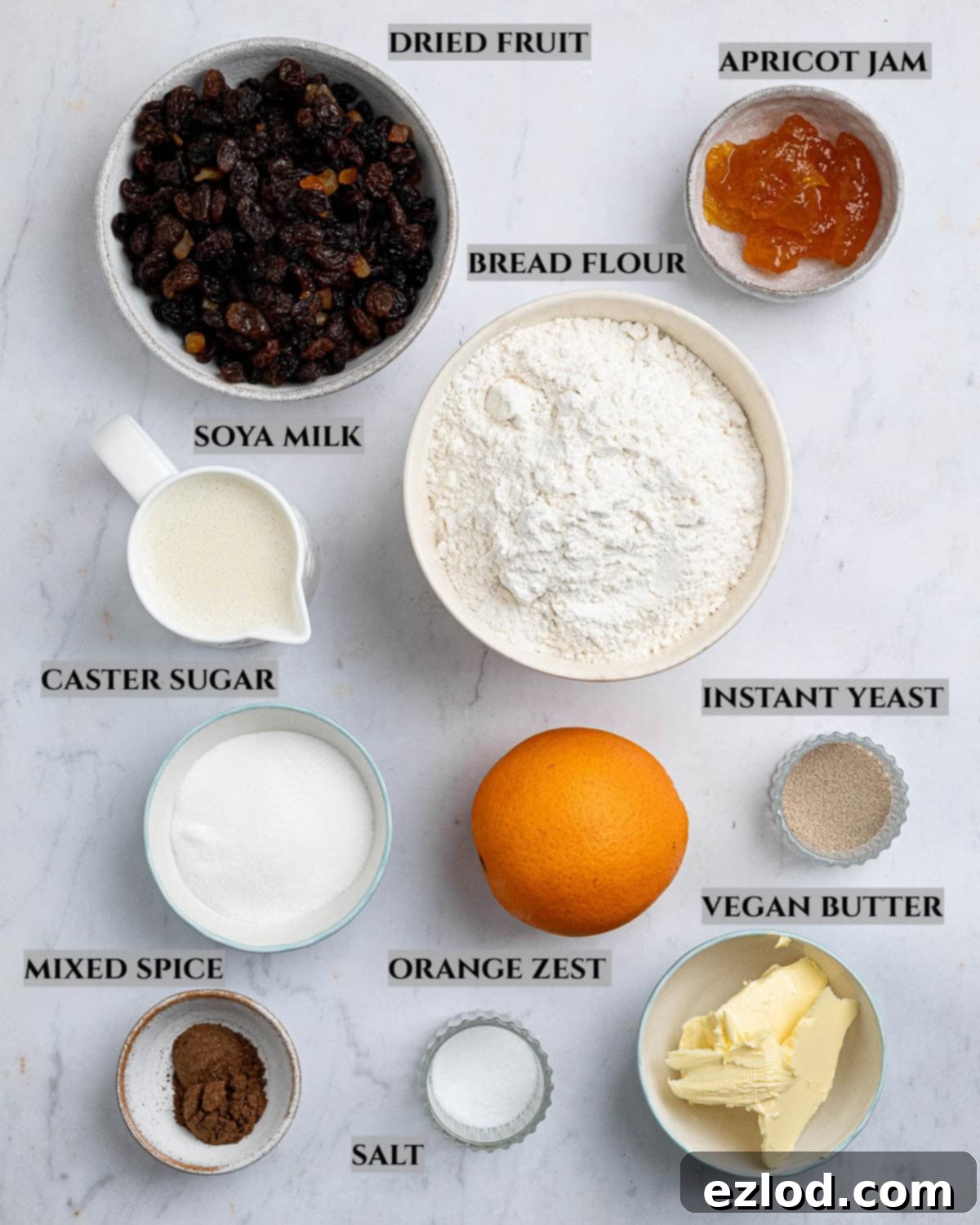
Essential Ingredient Details for Your Perfect Hot Cross Bun Loaf:
Understanding each ingredient’s role is key to achieving baking perfection. Here’s a breakdown of what you’ll need and why:
Bread Flour: For that signature soft, fluffy, yet slightly chewy texture characteristic of this hot cross bun loaf, white bread flour is your best choice. Its higher protein content develops more gluten, which is essential for trapping air and creating a light, airy crumb. While plain (all-purpose) flour can be used in a pinch, expect a slightly different texture, usually less airy and chewy. I strongly advise against using wholemeal flour as it will result in a much denser, heavier bread, which is not what we’re aiming for here.
Instant/Fast Action Yeast: My preference for bread making always leans towards instant or fast-action yeast. The convenience is unbeatable – it can be directly incorporated into the flour without the need for prior activation. This saves time and simplifies the process, making it perfect for both novice and experienced bakers alike. Ensure your yeast is fresh and not expired for optimal rising.
Salt: A non-negotiable ingredient in bread baking. Salt isn’t just for flavor; it plays a crucial role in controlling yeast activity and strengthening the gluten structure. Omitting it would lead to bland, unstructured bread, so please do not skip this vital component.
Non-Dairy Milk: Soy milk is my go-to for baking due to its higher protein content, which closely mimics the properties of dairy milk, contributing to a richer texture and flavor. However, most varieties of unsweetened non-dairy milk will work effectively. Just be sure to choose an unsweetened option to control the overall sweetness of the loaf.
Sugar: Caster sugar is used in the dough because its finer granules dissolve easily, ensuring an even distribution of sweetness without a grainy texture. If you only have granulated sugar on hand, it can be substituted, though it might take a moment longer to fully incorporate into the dough.
Vegan Butter: While I typically recommend block vegan butter for most baking applications due to its consistent fat content, a good quality tub variety will also work well for this recipe. Just be certain to avoid low-fat spreads, as they contain too much water and will negatively impact the dough’s texture and richness. Flora Original is a reliable brand I often use.
Mixed Dried Fruit: This recipe calls for a classic shop-bought mixture typically containing raisins, sultanas, currants, and candied peel. However, feel free to customize with your favorite dried fruits! If you’re using larger fruits like apricots, figs, or dates, remember to chop them into smaller, bite-sized pieces to ensure they are evenly distributed throughout the loaf and don’t clump together.
Mixed Spice: For those outside the UK, “mixed spice” is a traditional British blend of sweet spices commonly used in festive baking. It typically includes cinnamon, nutmeg, cloves, ginger, and allspice. It shares similarities with pumpkin pie spice but often has a slightly different balance, usually less dominant in cinnamon. You can easily substitute it with any sweet spice blend you enjoy, such as pumpkin spice or apple pie spice, to achieve a similar warm, aromatic profile.
Orange Zest: This is an optional but highly recommended addition. The finely grated zest of a large orange introduces a bright, citrusy note that beautifully complements the warm spices and dried fruit, adding an extra layer of fresh flavor to the loaf.
Apricot Jam or Maple Syrup for Glaze: To give the finished loaf its signature beautiful, shiny top, we brush it with a warmed, smooth apricot jam or maple syrup immediately after it comes out of the oven. Both options work wonderfully, so simply use whichever you have available in your pantry.
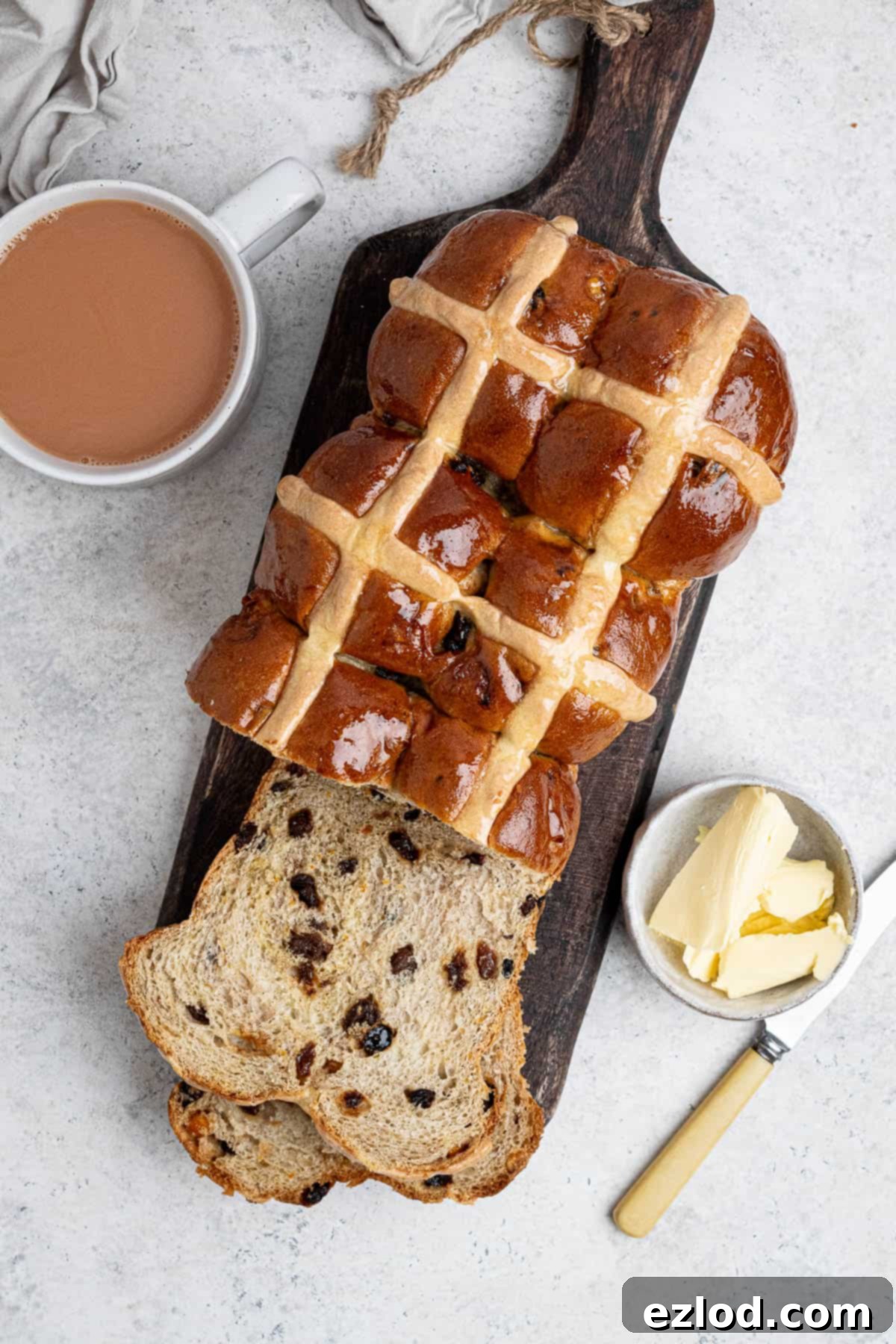
How To Master Your Vegan Hot Cross Bun Loaf:
(Full detailed measurements and precise instructions can be found in the comprehensive recipe card at the very bottom of the page)
The journey to creating this delectable hot cross bun loaf begins with the magical tangzhong. This method is the secret to its incredible softness and extended freshness.
Step 1: Preparing the Tangzhong Starter. In a small saucepan, combine the initial portion of flour and gradually whisk in the milk until a smooth, lump-free mixture forms. Place the pan over a gentle medium-low heat, whisking continuously. Keep whisking until the mixture transforms into a thick, paste-like, or pudding-like consistency. This process, where the starch in the flour gelatinizes, is what creates the extraordinary texture of the bread.
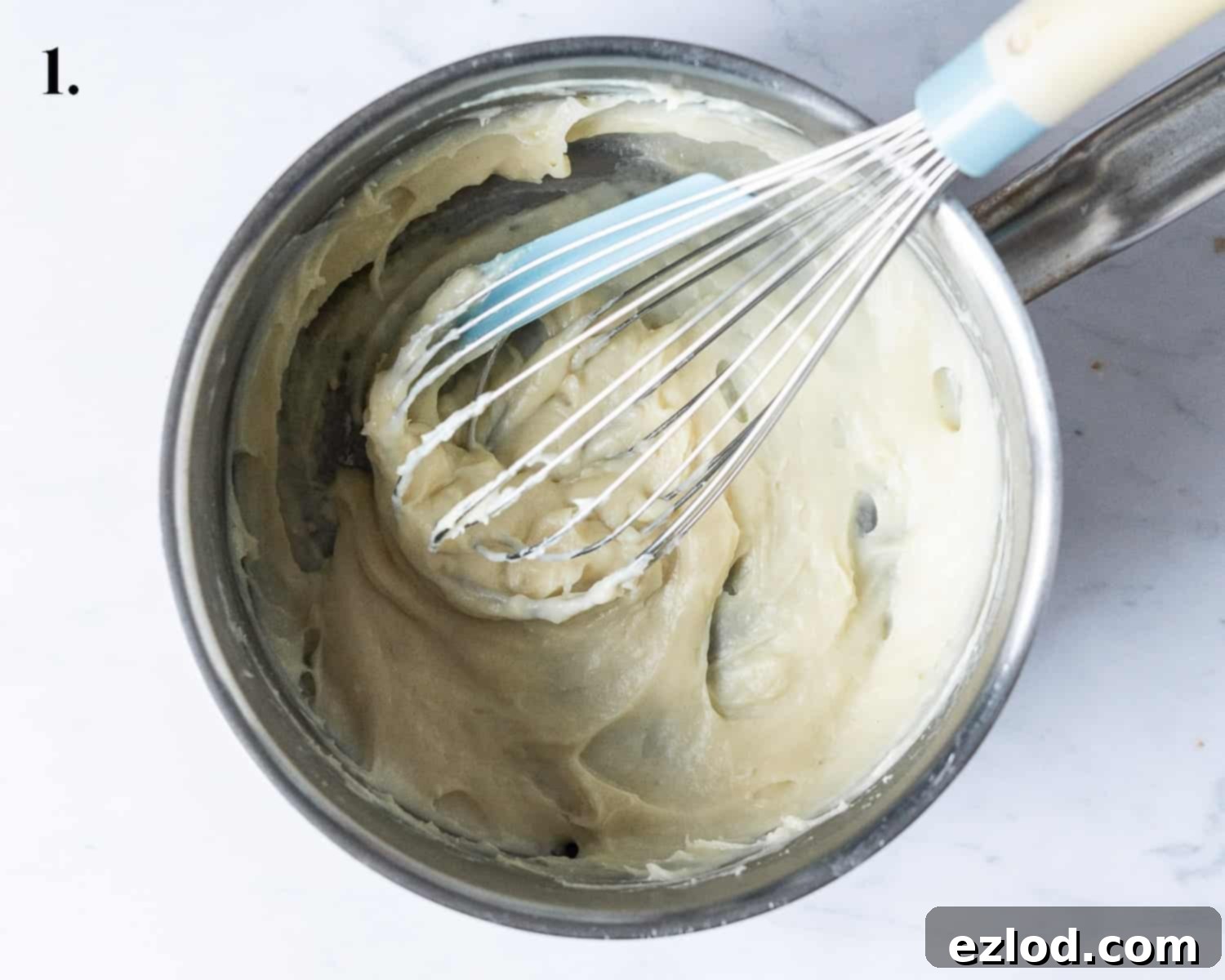
Step 2: Crafting the Dough. Carefully scrape the warm tangzhong mixture into the bowl of your stand mixer, fitted with a dough hook attachment. Immediately pour the cold milk over the tangzhong – this rapidly cools the mixture, preventing its heat from potentially inactivating the yeast. Add the sugar, salt, the remaining bread flour, and finally, the instant yeast. Begin mixing on a low speed until a shaggy, rough dough forms. Increase the mixer speed to medium and continue kneading until the dough becomes visibly smooth and stretchy. This initial kneading usually takes about 10 minutes. Next, add the softened vegan butter, incorporating it gradually. Continue kneading for another 5 minutes or so, until the butter is fully absorbed, and the dough becomes wonderfully smooth, elastic, and no longer feels greasy to the touch. The dough should still be soft and slightly sticky but should pull cleanly away from the sides of the bowl.
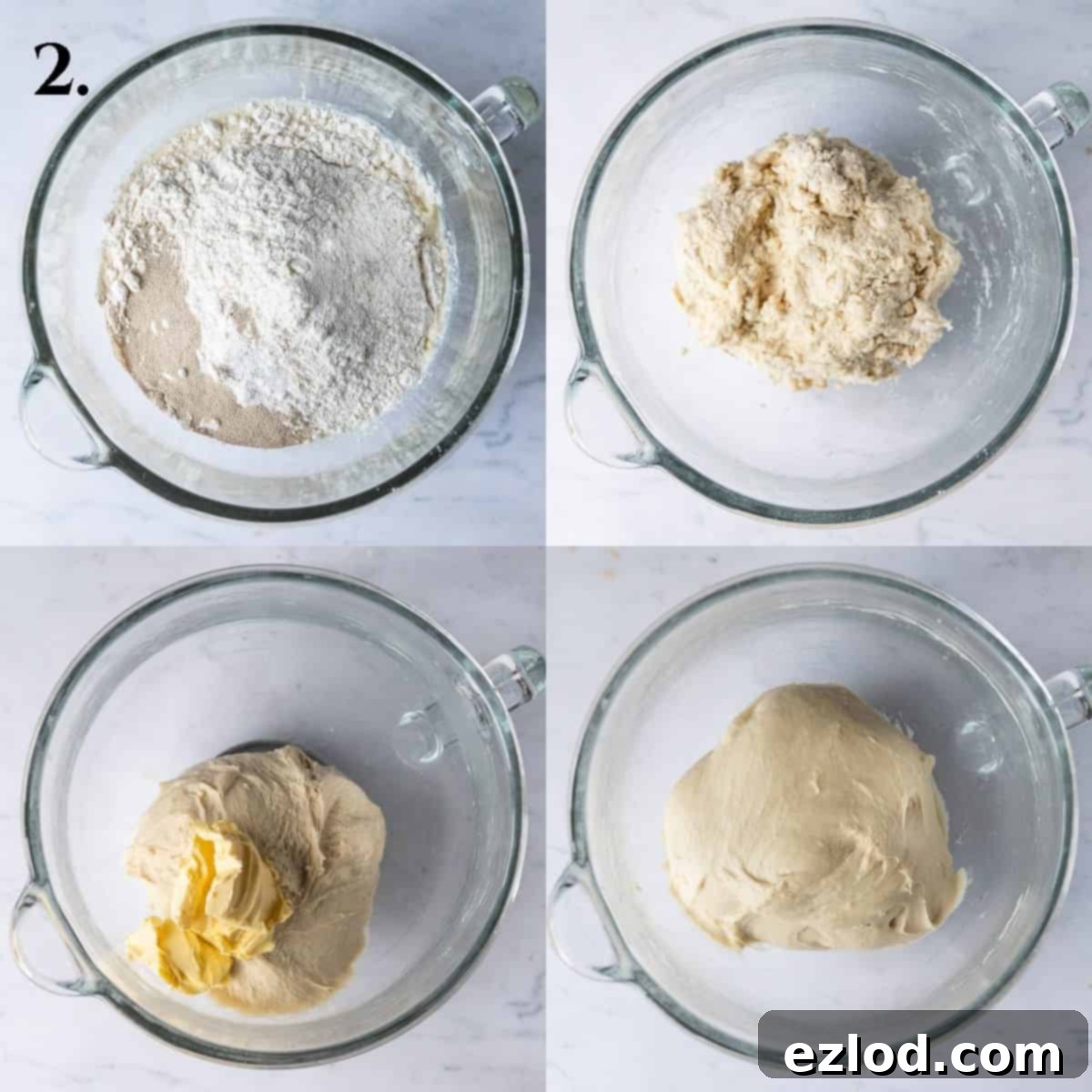
Step 3: First Rise (Bulk Fermentation). Lightly oil a clean bowl. Transfer the kneaded dough into the bowl, ensuring it’s well coated. Cover the bowl tightly with cling film or a damp tea towel. Place it in a warm, draft-free spot to rise. This first rise, or bulk fermentation, typically takes between 1-2 hours, or until the dough has at least doubled in size. If you prefer, you can also let it rise slowly overnight in the refrigerator for a deeper flavor development.
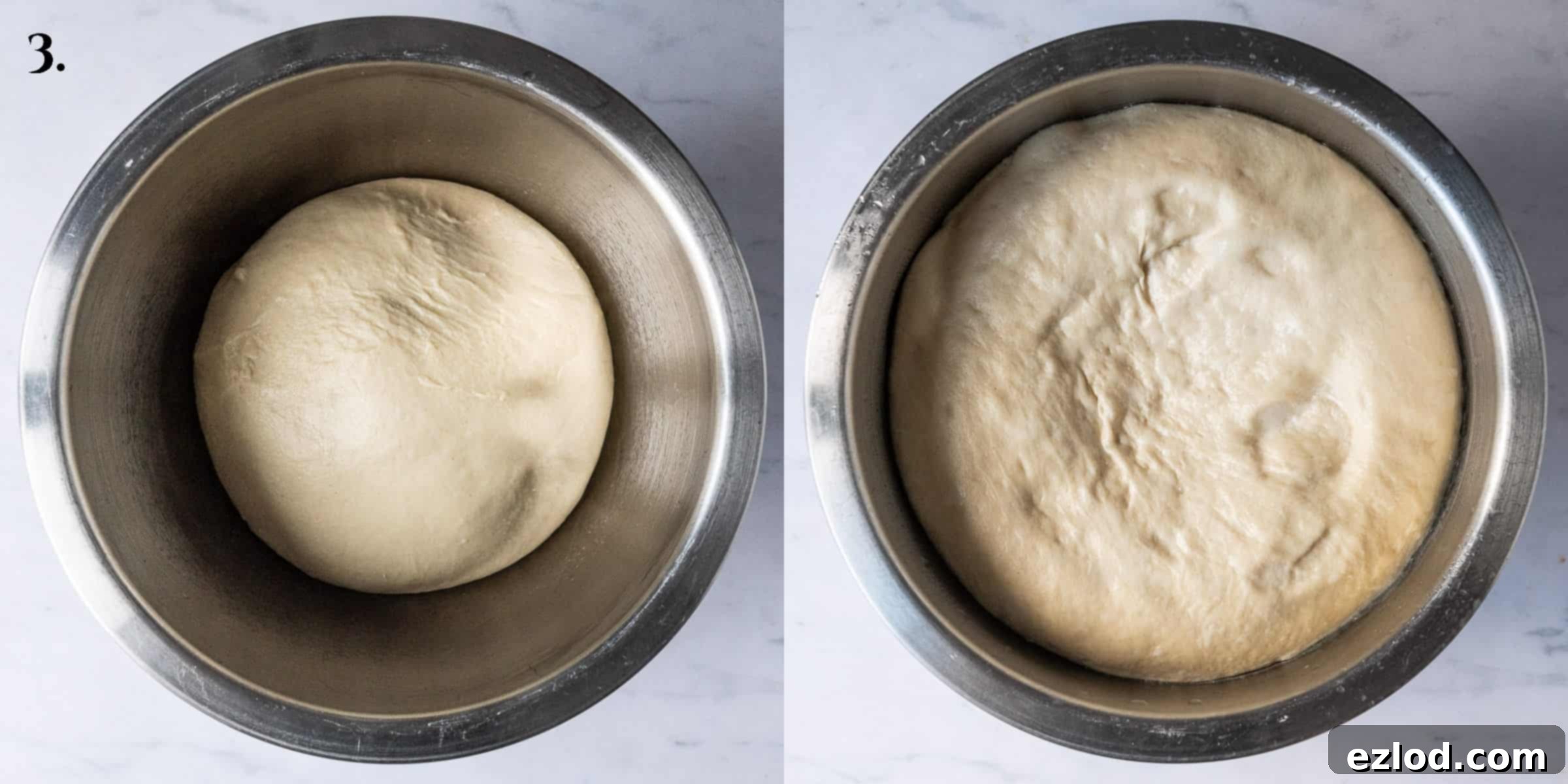
Step 4: Incorporating the Flavorful Mix-Ins. Once the dough has completed its first rise, gently punch it down to release the air. Transfer the dough to a lightly floured work surface. Using your hands, pat the dough out into a rough rectangular shape. Evenly scatter the mixed spice, orange zest, and mixed dried fruit over the surface of the dough. Carefully roll the dough up tightly, ensuring all the mix-ins are enclosed within. Knead the dough for a couple of minutes to ensure the fruits and spices are thoroughly and evenly distributed throughout. This dough can be quite sticky, so a bench scraper will be incredibly useful here to help manage it without adding excessive flour.
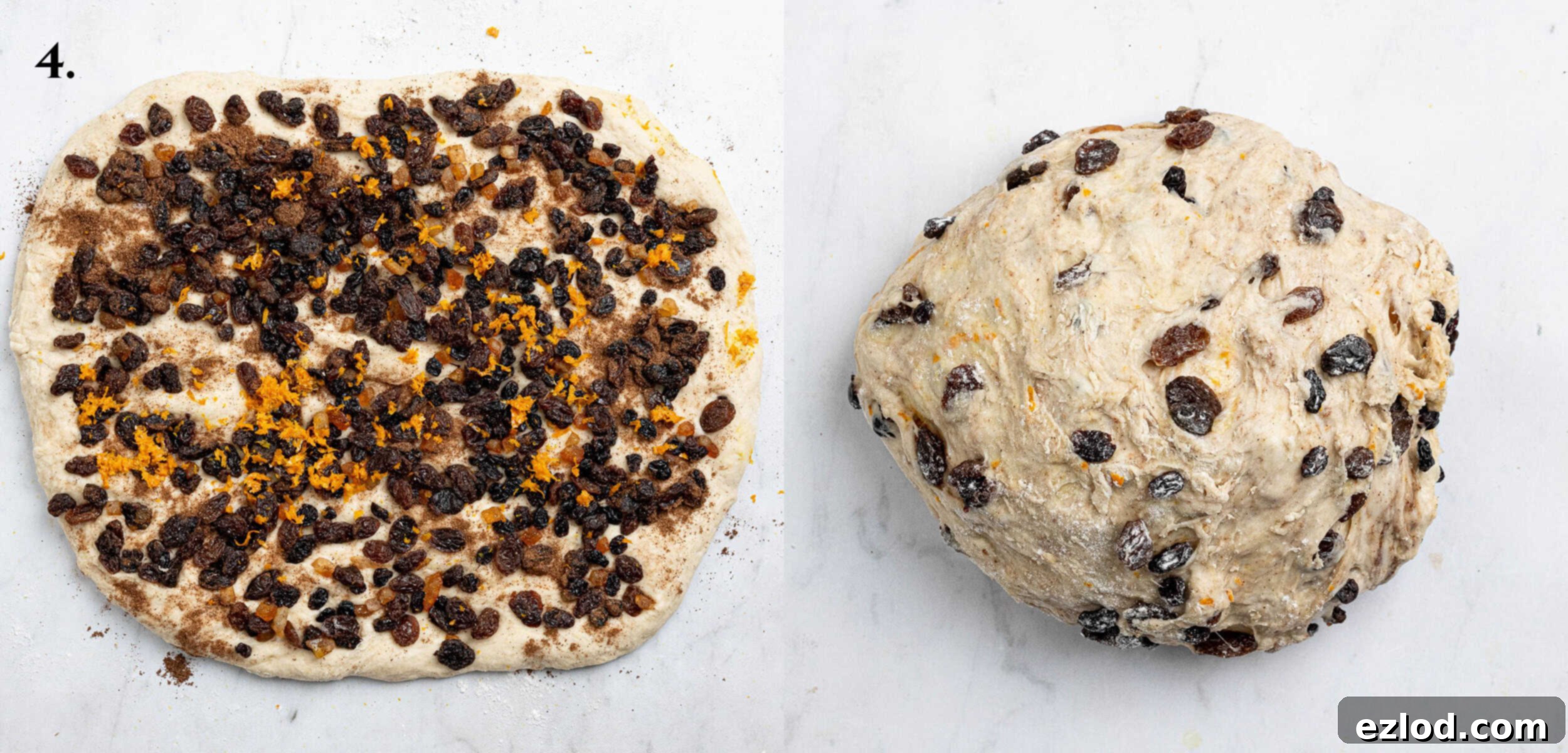
Step 5: Dividing the Dough. For consistent loaf size, it’s best to use a kitchen scale for this step. Divide the dough into six equal pieces. Roll each individual piece into a smooth, tight ball.
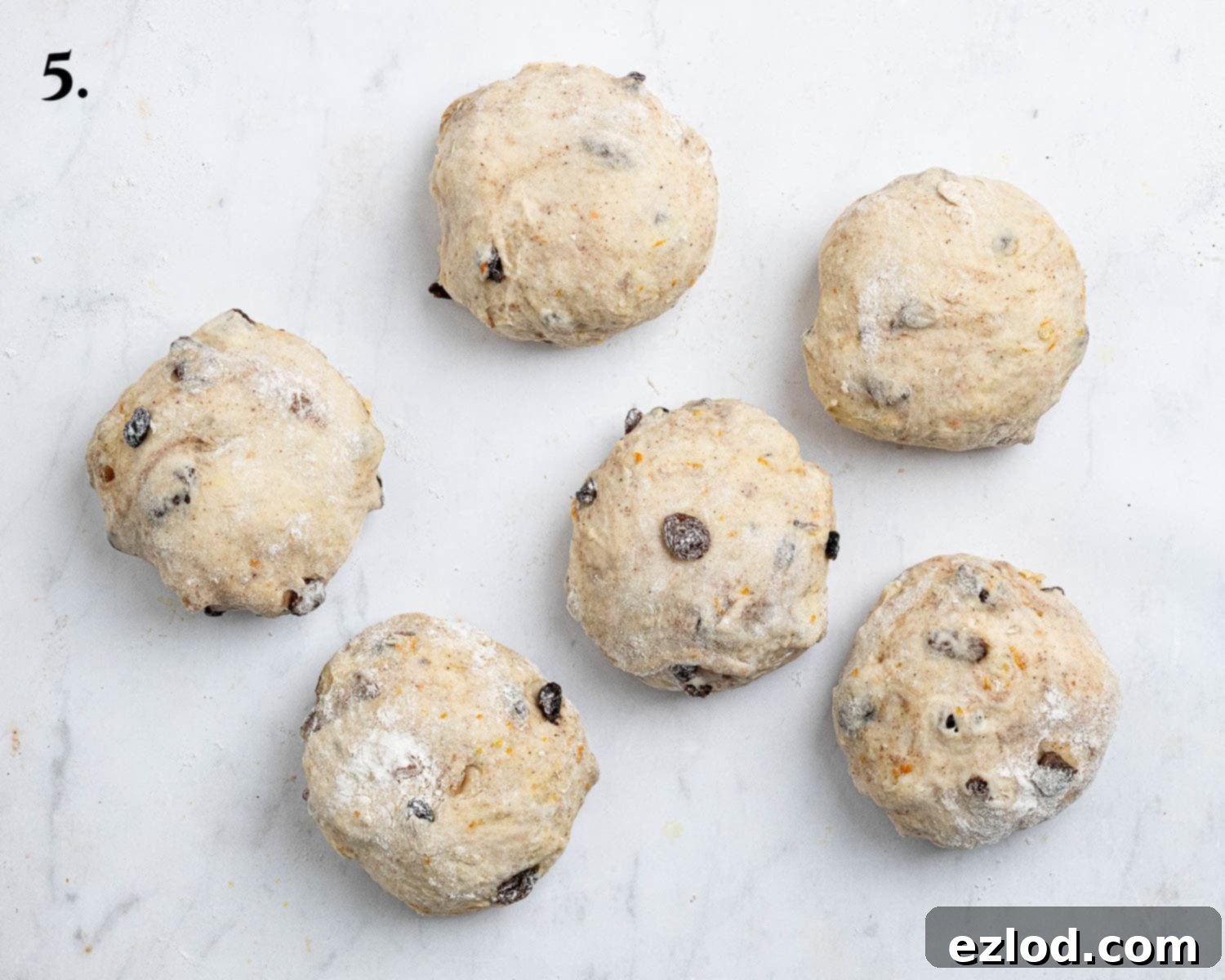
Step 6: Shaping the Buns for the Loaf. On a lightly floured surface, take one dough ball and roll it out into a rough oval shape. Fold one-third of the oval over the middle (folding from the long side). Then, fold the other third over the top, creating a long, narrow packet. Gently roll over the seam to flatten and seal it. Finally, roll the packet up from one end to create a fat, compact sausage shape. Repeat this shaping process for all the remaining dough balls.

Step 7: Second Rise (Proofing in the Loaf Tin). Arrange the six shaped dough balls into your prepared loaf tin. Position them in two rows of three, ensuring the seams are facing downwards. Cover the loaf tin loosely with oiled cling film or a damp cloth. Place it in a warm location to rise for its second proofing. This rise will take approximately 1-2.5 hours, or until the dough has significantly increased in size, at least doubling. A good test is to gently press the dough with a finger; if the indentation slowly springs back but remains visible, it’s ready. If it springs back too quickly, it needs more time.
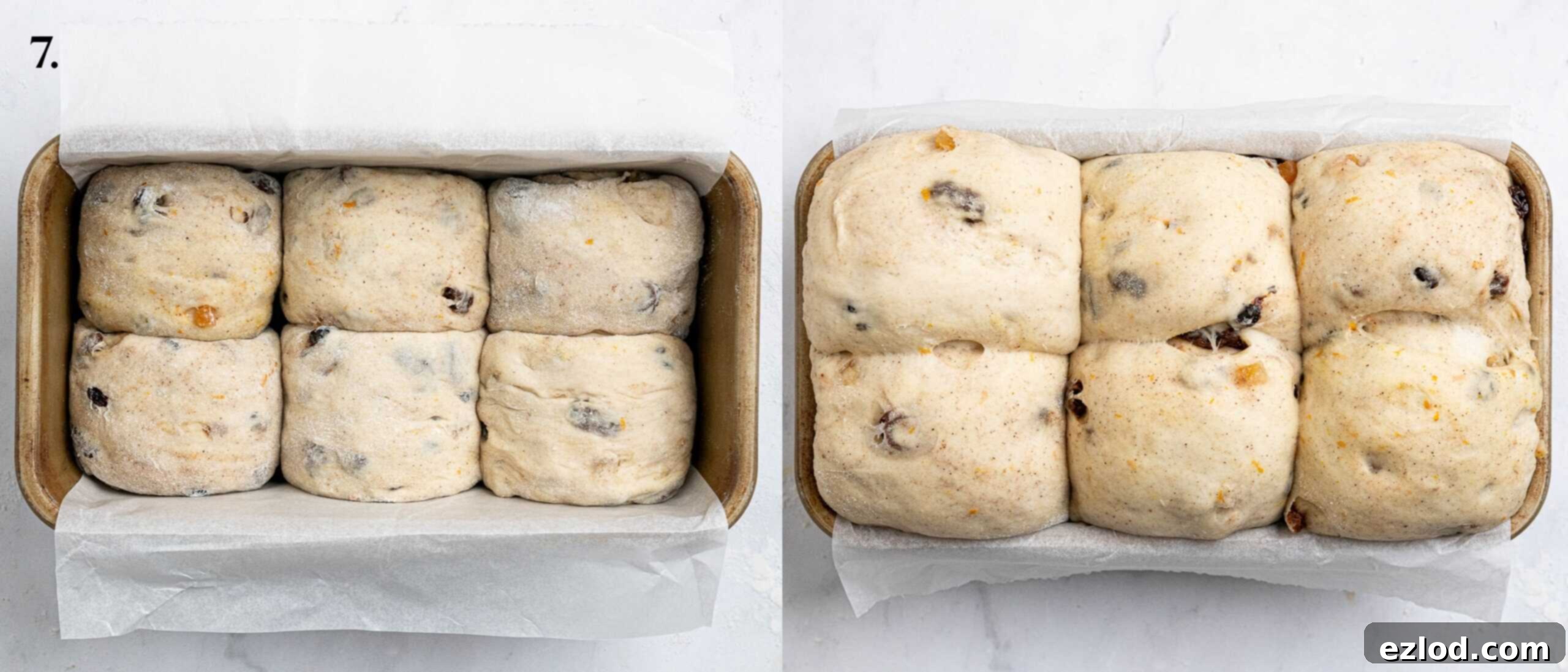
Step 8: Preparing and Piping the Crosses. While the dough is completing its second rise, prepare the cross mixture. In a small bowl, combine the plain flour with milk, stirring gradually until you achieve a thick but still pourable paste. Transfer this paste into a small disposable piping bag. Snip off a small tip from the bag. Once the loaf has fully risen, carefully pipe a cross pattern onto the top of each individual bun within the loaf.
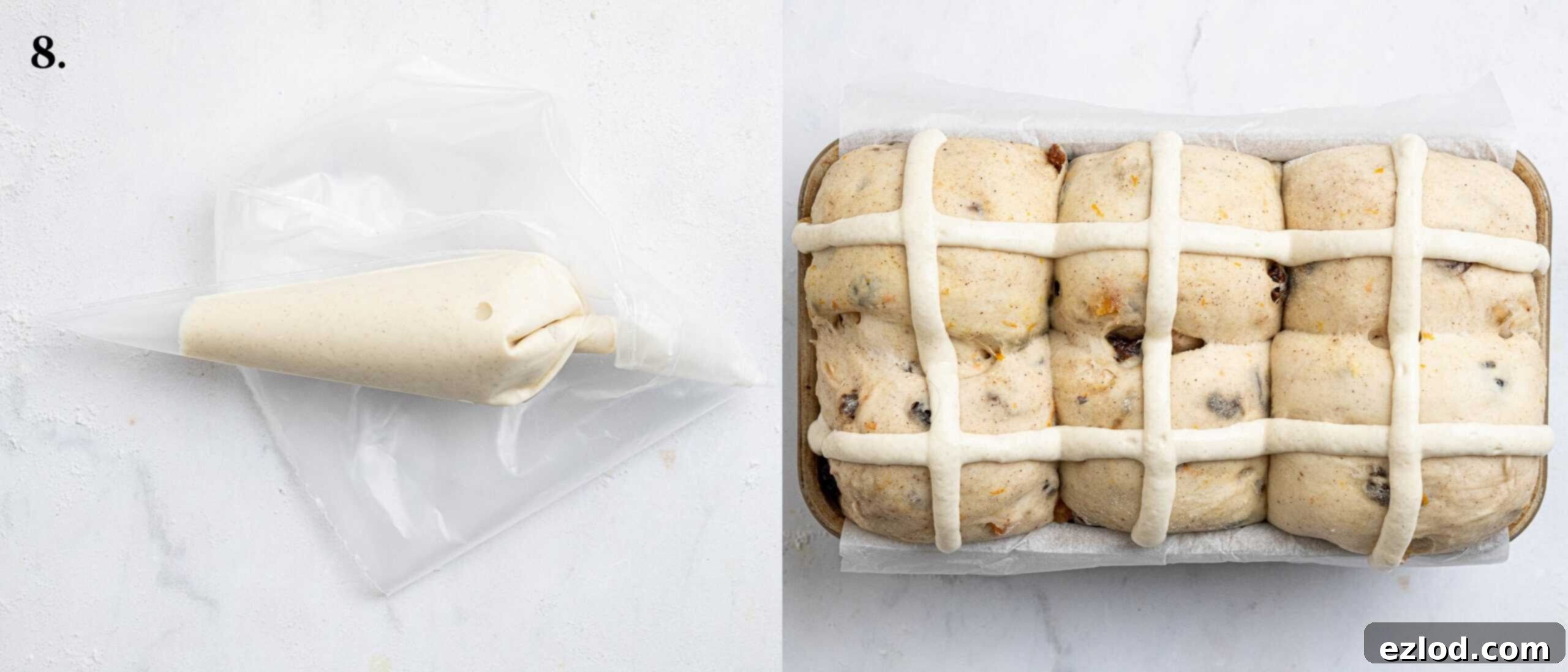
Step 9: Baking and Glazing. Preheat your oven to 180°C (160°C fan/350°F/gas mark 4). Bake the loaf on the lower-middle shelf for approximately 40-50 minutes. The bread should be golden brown, sound hollow when tapped on the bottom, and ideally, an internal probe thermometer should register at least 90°C (194°F). If the loaf begins to brown too quickly, loosely tent it with foil partway through baking. Once baked, remove the loaf from the oven. Gently warm the apricot jam until it’s runny, then immediately brush it generously over the entire warm loaf. This creates a beautiful, shiny glaze. Transfer the glazed loaf to a wire rack and allow it to cool completely before slicing and serving. Patience is key for the best texture!
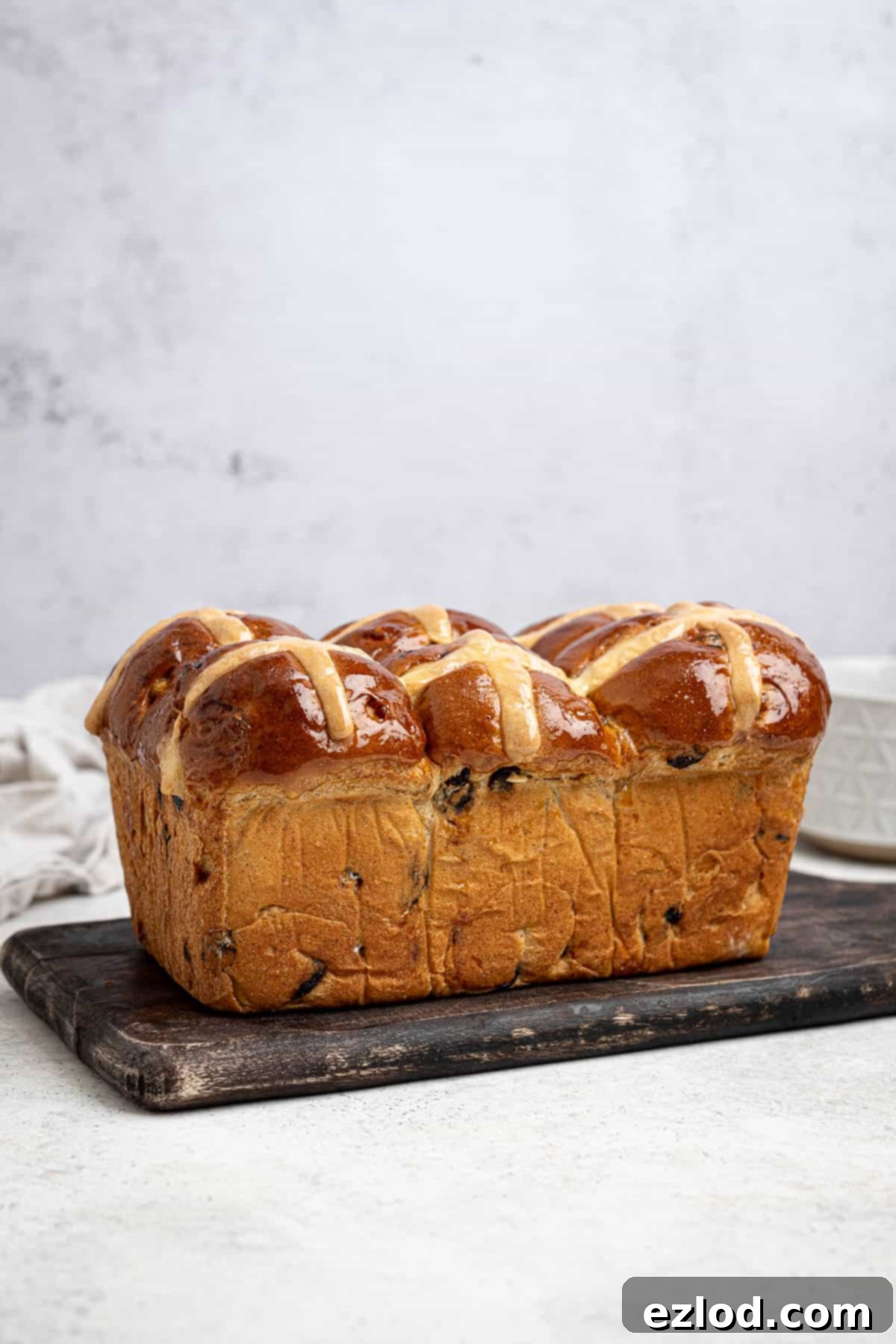
Top Tips for Bread Baking Success:
Achieving a consistently excellent loaf involves a few key practices:
- **Embrace Metric Measurements:** As with all baking, I highly recommend using metric measurements with a digital kitchen scale rather than imprecise cup conversions. A scale provides far more accurate and consistent results, making your baking experience easier and less messy.
- **Yeast Vitality is Key:** Always double-check the expiration date of your yeast! Old or inactive yeast is a common culprit for bread that fails to rise, leading to a dense and disappointing result.
- **Dough Hydration Adaptability:** The precise amount of flour needed can sometimes vary. Different brands of flour absorb liquid differently, and even environmental factors like humidity can play a role. Start with the specified quantity in the recipe, and if the dough feels excessively wet or sticky after the initial kneading, add a little more flour, one tablespoon at a time, until it reaches the desired consistency. Remember, this is meant to be a soft and somewhat sticky dough, so avoid adding too much extra flour, as this will result in a dry and tough bread.
- **Overnight Rise for Enhanced Flavor:** For a deeper flavor profile and to break up your baking workload, consider performing the first rise overnight in the refrigerator instead of at room temperature. This slow fermentation develops more complex flavors. If you opt for an overnight cold proof, remember that the second rise the following day will likely take longer as the dough needs to come back up to room temperature and reactivate.
- **Temperature Affects Rising Times:** Be mindful that the rising time of your dough will fluctuate based on the ambient temperature of your kitchen. On warmer days, the dough will prove much faster than on colder days. Adjust your timing accordingly and rely on visual cues (doubled in size) rather than strict clock times.
- **Internal Temperature for Doneness:** The most accurate way to determine if a loaf of bread is perfectly cooked through is by using a probe thermometer. Oven temperatures can vary widely, making “one-size-fits-all” baking times unreliable. The bread is fully cooked when its internal temperature reaches 90°C (195°F).
- **Preventing Burnt Raisins:** When arranging the shaped dough balls in the loaf tin, inspect them and pick off any raisins or dark dried fruit pieces that are directly exposed on the surface. These small pieces can burn during baking, leading to bitter spots.
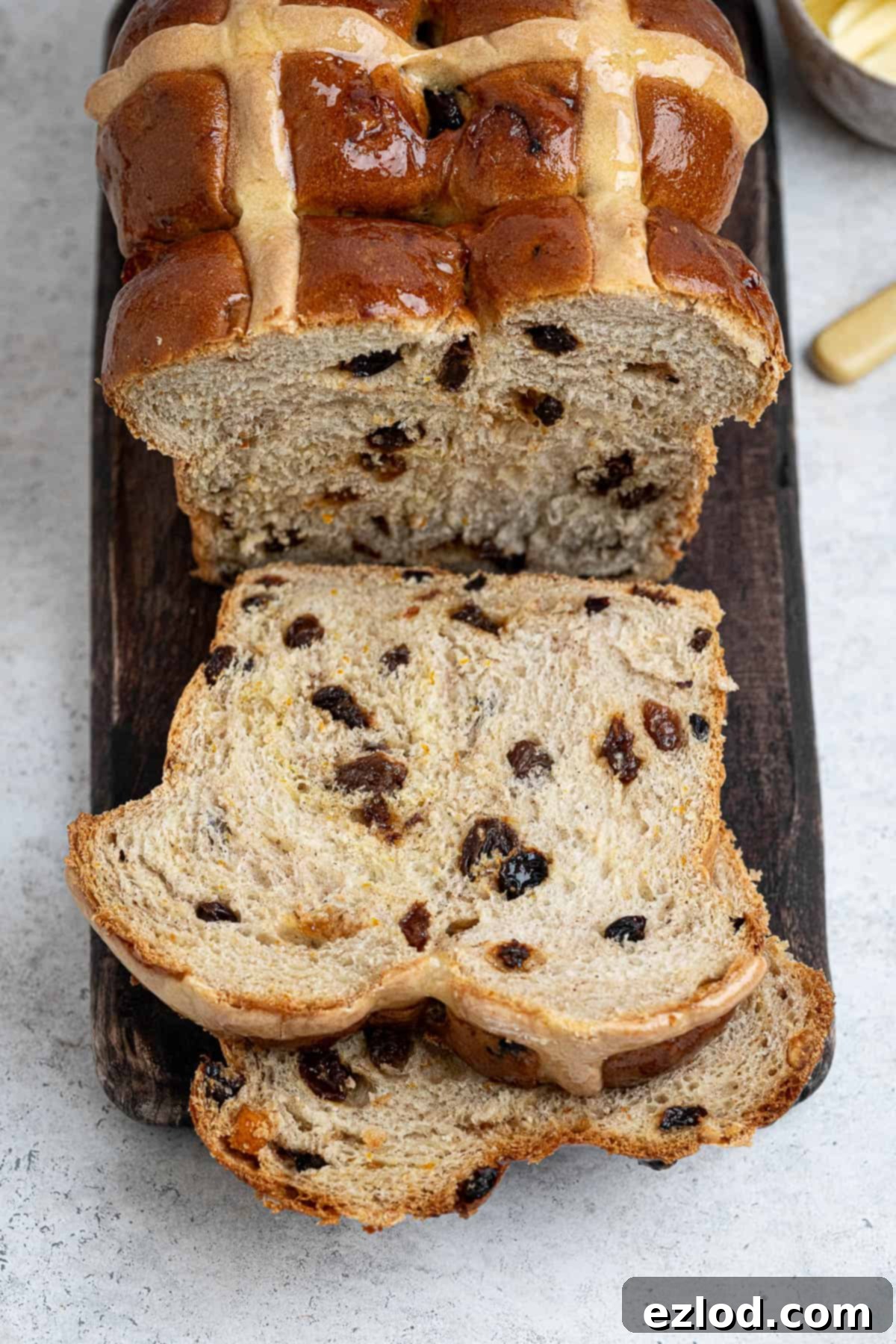
Frequently Asked Questions (FAQ’s):
To maintain its delightful softness and freshness, store the hot cross bun loaf in an airtight container at room temperature. It will remain delicious for up to 3 days. For longer storage, consider freezing it.
Absolutely, this bread freezes exceptionally well! To preserve its peak freshness, allow the loaf to cool completely after baking, then freeze it on the same day. You can freeze it either whole or pre-sliced. Ensure it is very well wrapped in plastic wrap and then foil to prevent freezer burn and maintain its quality. Thaw at room temperature or gently warm slices in a toaster.
This particular dough is quite soft and sticky, which makes a stand mixer the easiest tool for kneading. However, if you don’t have a stand mixer, you can certainly knead it by hand – just be prepared for a slightly messier, more labor-intensive process! When hand-kneading, avoid adding excessive flour to your surface, as this can make the dough too dry and tough. Instead, if the dough is sticking too much, lightly oil your work surface and your hands to help manage it. A bench scraper will be an invaluable tool to help unstick the dough from your surface and gather it during the kneading process.
Unfortunately, this recipe is not suitable for gluten-free flour. Crafting successful gluten-free bread requires a fundamentally different approach to ingredients and ratios, and the entire recipe would need to be re-engineered. Gluten-free baking is a specialized area outside my expertise, so I cannot provide specific advice for adapting this recipe. For reliable gluten-free results, it’s always best to use a recipe specifically developed for gluten-free ingredients rather than attempting to adapt a traditional wheat-based recipe.
Discover More Sweet Vegan Breads:
If you loved this Hot Cross Bun Loaf, you’re in for a treat! Explore our collection of other delightful sweet vegan bread recipes that are perfect for any occasion:
- Apple Cinnamon Pull-Apart Bread
- Maple Pecan Bread Wreath
- Lemon Coconut Pull-Apart Bread
- Jamaican Spice Bun
- Vegan Banana Monkey Bread
- Vegan Pumpkin Pecan Babka
- Almond Bread Twist
- Vegan Stollen Wreath
- Vegan Chocolate Babka
- Plum and Marzipan Bread
- Apple Cinnamon Brioche
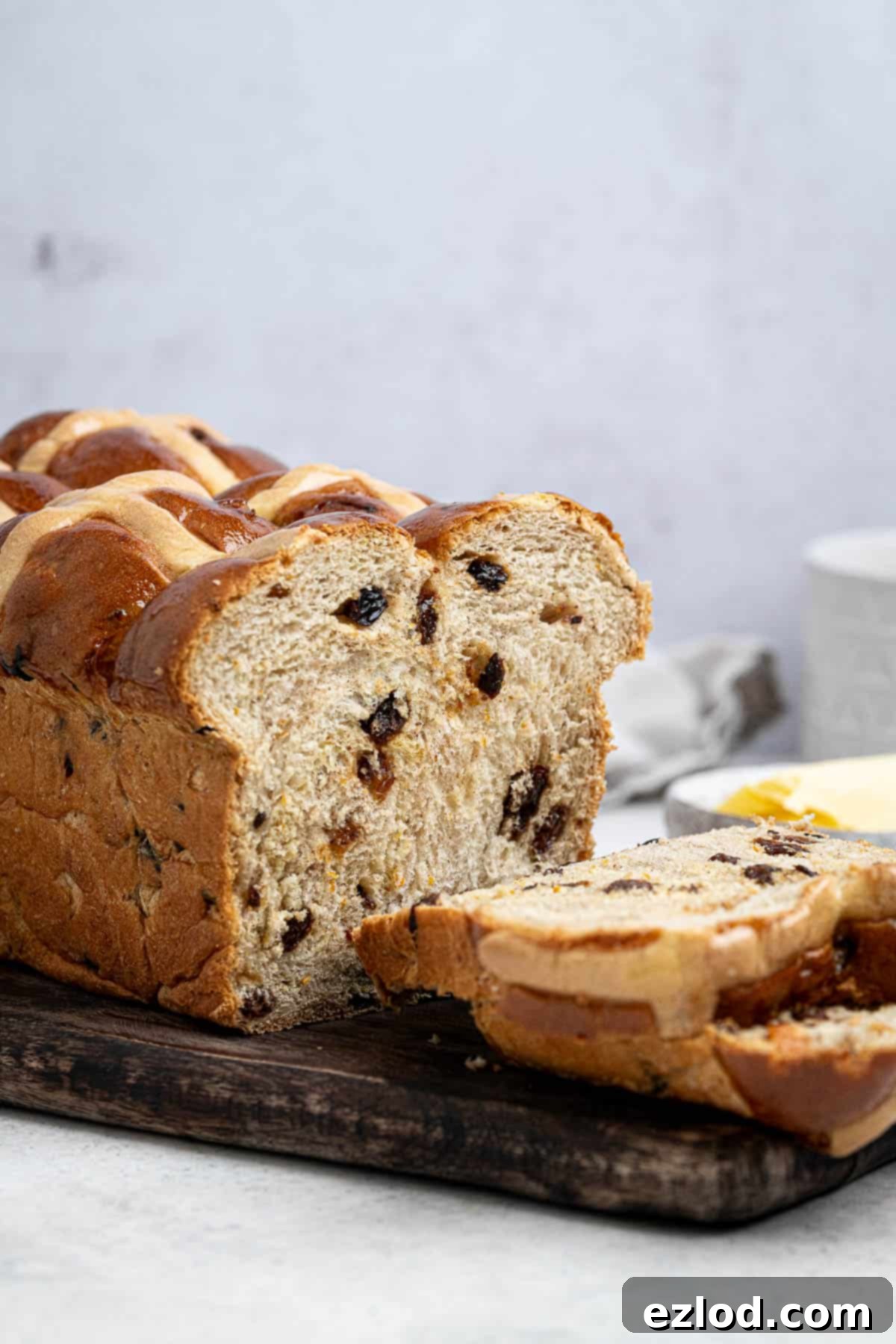
If you tried this delightful Vegan Hot Cross Bun Loaf recipe, we’d love to hear from you! Please take a moment to rate it, leave a comment sharing your experience, or tag @domestic_gothess on Instagram and use the hashtag #domesticgothess to share your beautiful creations!
All images and content on Domestic Gothess are copyright protected. If you wish to share this recipe, please do so by utilizing the provided share buttons. We kindly request that you do not screenshot or post the full recipe or content; instead, include a direct link back to this post for the complete recipe. Thank you for respecting our work!

Print
Hot Cross Bun Loaf (vegan)
Ingredients
Tangzhong
- 25 g (3 Tablespoons) white bread flour
- 140 g unsweetened non-dairy milk (I use soy)
Dough
- 160 g (⅔ cup) unsweetened non-dairy milk (I use soy) cold
- 60 g (4 ½ Tablespoons) caster or granulated sugar
- 1 teaspoon salt
- 350 g (scant 3 cups) white bread flour
- 7 g (2 ¼ teaspoons) instant/fast action yeast
- 40 g (3 Tablespoons) vegan butter softened
Mix-Ins
- 2 teaspoons mixed spice
- finely grated zest of 1 large orange
- 200 g mixed dried fruit (raisins, sultanas, currants and candied peel)
Crosses
- 2 Tablespoons plain flour
- about 2 Tablespoons milk
- 2 Tablespoons clear apricot jam or maple syrup to glaze
Instructions
-
To make the tangzhong, place the flour in a saucepan and gradually whisk in the milk to avoid lumps. Place the pan over a medium/low heat and whisk constantly until the mixture has thickened to a paste/pudding-like consistency.25 g (3 Tablespoons) white bread flour, 140 g unsweetened non-dairy milk (I use soy)
-
Scrape the tangzhong into the bowl of a stand mixer fitted with a dough hook and pour the cold milk on top. This will cool the tangzhong down so that the heat doesn’t kill the yeast.160 g (⅔ cup) unsweetened non-dairy milk (I use soy)
-
Add the sugar, salt and flour and finally the yeast. Stir until it forms a rough dough then set the stand mixer to a medium speed and mix until the dough is smooth and stretchy, this can take about 10 minutes.60 g (4 ½ Tablespoons) caster or granulated sugar, 1 teaspoon salt, 350 g (scant 3 cups) white bread flour, 7 g (2 ¼ teaspoons) instant/fast action yeast
-
Add the vegan butter and knead for about another 5 minutes until it is fully incorporated and the dough is smooth, elastic and no longer feels greasy. You may need to scrape down the sides of the bowl a couple of times.40 g (3 Tablespoons) vegan butter
-
The dough should still be soft and sticky, but it should pull away from the sides of the bowl cleanly. If it seems too wet then you can knead in a little extra flour, a tablespoon at a time. Be careful though, this is meant to be a soft dough and adding too much extra flour will make the bread dry. It should pass the windowpane test – stretch the dough with your hands, you should be able to stretch it to a very thin, almost transparent membrane without it tearing. This can take up to 20 minutes of kneading, especially by hand.
-
Place the dough in a lightly oiled bowl and cover with clingfilm, leave to rise for 1-2 hours until well doubled in size. Alternatively, place it in the fridge to rise overnight. If you refrigerate it, the following day let it come up to room temperature for about half an hour before continuing.
-
Line a 2lb loaf tin with baking parchment. Once the dough has risen, punch it down and fold it in on itself a couple of times to knock out the air.
-
On a lightly floured surface, pat the dough out into a rough rectangle. Scatter over the mixed spice, orange zest and mixed dried fruit. Roll the dough up tightly to enclose the mix-ins then knead it for a couple of minutes until they are well distributed. It will be quite sticky so use a bench scraper to help you mix it; alternatively you can mix it in a stand mixer.2 teaspoons mixed spice, finely grated zest of 1 large orange, 200 g mixed dried fruit (raisins, sultanas, currants and candied peel)
-
Divide the dough into six equal pieces (use a scale) and roll each one into a ball.
-
On a floured surface, roll each ball out into a rough oval shape, fold one third of the oval over the middle (from the long side, not the top), then the other third over the top to form a long, narrow packet. Roll over the seam to flatten it, then roll it up from one end to make a fat sausage. Repeat with the other balls of dough.
-
Arrange the shaped balls of dough in the loaf tin in two rows of three, seam side down. Pick off any raisins that are on the surface as they will burn in the oven.
-
Loosely cover with oiled clingfilm and leave to rise in a warm spot until at least doubled in size, this can take 1-2 ½ hours. If you press the dough gently with a finger the indentation should spring back slowly but remain visible. If it springs back quickly it needs to prove for a little longer. Preheat the oven while the dough is rising to 180°C/160℃ fan/350°F/gas mark 4.
-
To make the crosses, place the flour in a small bowl and gradually stir in the milk until you have a thick but pourable paste. Transfer the paste to a small disposable piping bag and snip off the tip, pipe a cross on the top of each bun.2 Tablespoons plain flour, about 2 Tablespoons milk
-
Bake the loaf on the lower middle shelf of the oven for 40-50 minutes until well risen and the bread sounds hollow when tapped on the bottom, the internal temperature should reach at least 90°C/194°F on a probe thermometer. Cover the bread with foil partway through baking if needed to stop it from becoming too dark.
-
Gently heat the apricot jam until runny, transfer the cooked loaf to a wire rack and brush generously all over with the jam or maple syrup. Leave to cool completely before slicing.2 Tablespoons clear apricot jam or maple syrup to glaze
